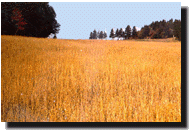
Field crops grown in Prince Edward
Island are classified as cereals, proteins, and forages.
Cereals are members of the grass family, producing edible
parts called seeds, which are food for both humans and
livestock. The most commonly grown cereals on the Island
are barley; mixed grain (a combination of oats and
barley, grown together), spring wheat; oats; and  winter wheat. Most of these
are grown for livestock feed, but a small amount of the
wheat is milled into flour. The province is 90 percent
self-sufficient in cereal production for livestock.
winter wheat. Most of these
are grown for livestock feed, but a small amount of the
wheat is milled into flour. The province is 90 percent
self-sufficient in cereal production for livestock.
Winter wheat is also a winter cover crop useful in
rotation with potato production. It is sown in early
September and harvested the following August. The other
cereals are planted in spring (May or June) and harvested
in early fall using combines.
The major protein crop on Prince Edward Island is the
soybean. A member of the legume family, soybeans are
included in animal feeds to improve the protein quality
of rations. There is room for growth in this sector as
the province imports a large percentage of the protein
required for livestock rations. Soybeans are sown in May
or June and are among the last crops to be harvested,
usually by the end of October, as they are the last crop
to reach maturity.
Forages represent a vital component of agriculture in
Prince Edward Island as they represent an economical feed
for beef, dairy, sheep, and horse sectors. Forages are
also a useful rotation crop in potato production. They
add organic matter to the soil, thereby improving soil
texture and its ability to regulate moisture and air.
Alfalfa and clovers are especially effective at adding
valuable nitrogen to the soil. Other forage crops include
early hybrid corns, annual ryegrass and brassicas.
In the livestock industry, forage takes the form of
summer pasture and in winter, it is conserved as hay or
silage. Hay is made by cutting forage while it is still
at 80 percent moisture. It is then left to wilt until the
moisture level drops to 20 percent. At this point, the
hay is safe to store, as it is too dry to support fungal
growth. Silage differs from hay in that it is stored at a
higher moisture level (45 percent to 65 percent). The
silage is stored in an airtight environment to allow
bacteria to grow. The growth of bacteria creates lactic
acid which effectively pickles, i.e., preserves the
forage. Silage containers are easily recognizable,
resembling giant white (or occasionally black)
marshmallows strewn about Island fields.
While silage is highly beneficial to farmers who wish to
prevent field losses from wet weather, it also helps
streamline harvest processes for farms with large volumes
of forage. Over the past ten years, Island hay has been
an increasingly popular export to Newfoundland, England,
and Ireland.
Potatoes | Fruits and Vegetables |
Beef and Dairy | Swine
Poultry and Eggs | Emerging Commodities |
Beekeeping
